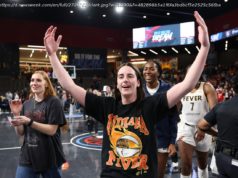For a few years during World War II, college football was transformed when military training camps fielded their own squads. Iowa Pre-Flight was one of those teams.
The final 1943 Associated Press college football poll had a lot of familiar names: Notre Dame, Michigan, Washington and Texas were all ranked in the Top 20.
But among the top 10 were some teams you won’ t find in this season’s poll: No. 2, Iowa Pre-Flight; No. 6, Great Lakes Navy; No. 8, Del Monte Pre-Flight; and No. 10, March Field.
The world of college football was transformed for a few years during World War II, when military training camps fielded their own teams, which competed with college football’s best.
The service teams had the advantage of older players, some of them former professionals, who were preparing for military service. Dick Todd, 29, Iowa Pre-Flight’s fullback, had already played four seasons with the Washington Redskins, the team he would rejoin for four more years after the war. Perry Schwartz was an end with the Brooklyn Dodgers of the N. F. L. There were Bears, Rams and Giants alumni as well.
Having lost players to the armed forces, college teams were often shorthanded. Many dropped football altogether. The shortage allowed freshmen to play temporarily for the varsity.
Iowa Pre-Flight was based at the University of Iowa, in Iowa City. But the team was distinct from the university’s Hawkeyes.
The Seahawks, as the Iowa Pre-Flight squad was known, were mostly a traveling team in 1943, playing just two home games at Iowa Stadium (now known as Kinnick Stadium) . The team was coached by the former Missouri coach Don Faurot, orginator of the Split-T formation, then a lieutenant. Bud Wilkinson, who went on to become a coaching legend at Oklahoma, was his assistant.
The Seahawks were involved in the biggest game of 1943, a battle of unbeatens with Notre Dame. Both were 8-0, although Notre Dame had played a tougher schedule that included wins over Michigan and strong Army and Navy squads.
The Seahawks were hampered by some injuries and by the last-minute transfer of six players, including their starting quarterback, Jack Williams, to other bases.
The game was played on Nov. 21,1943. American forces had just invaded Tarawa, an atoll in the Pacific. British troops had captured the town of Archi, in Abruzzo, Italy. The Germans and Russians were battling in the Kiev bulge. And the biggest football game of the year was played in South Bend, Ind.
Anticipation was high. Notre Dame had Johnny Lujack at quarterback who, after a stint in the Navy, would go on to win the Heisman Trophy in 1947 and play for the Bears. He was replacing Angelo Bertelli, who would win the Heisman later that year despite an abbreviated season. Bertelli had been called up to the Marines after Notre Dame’s first six games and eventually fought on Iwo Jima.
The line — even war doesn’ t stop gamblers from betting — was Notre Dame by 20 points
“Whether a top-flight college football team is in the same class with a crack professional club long has been a hypothetical puzzler, ” The New York Times mused before the game.
In those days, the college game was more popular than the fledgling N. F. L., and many stars did not even bother to go pro. The game between Iowa Pre-Flight and Notre Dame was going to answer that question.
To the surprise of the 45,000 people in attendance, mighty Notre Dame fell behind, 13-7. Only a late 6-yard touchdown by running back Creighton Miller, who led the nation in rushing that year, gave Notre Dame the victory, 14-13. Todd, the Iowa Pre-Flight quarterback, suffered a broken jaw in the fourth quarter, and the Seahawks offense stalled.
“Any doubts as to the majestic stature of the Notre Dame football team of 1943 melted today in the crucible of one of the great gridiron games of this or any other season, ” The Times concluded .
The win seemed to seal Notre Dame’s status as the country’s best team, college or otherwise. But the Irish were upset in their final game, 19-14, by another service team, the Great Lakes Bluejackets, based near Chicago.
“If football history has recorded a more shocking frustration of a great team than this last-minute bursting of Notre Dame’s bubble by Great Lakes, this observer has no recollection of it, ” Allison Danzig wrote in The Times .
Great Lakes had lost twice, so the Irish hung on to the No. 1 ranking, helped by having beaten five top-10 teams.
In 1944, the top-ranked base team was Randolph Field from San Antonio, which was No. 3 behind Army and Ohio State. Iowa Pre-Flight lost its opener to Michigan and finished No. 6. The Great Lakes team was 9-2-1 to finish 17th. The coach was a newly commissioned navy lieutenant, none other than the future N. F. L. Hall of Fame coach Paul Brown, who led the Cleveland Browns to three league titles.
“The admiral told me it was good for morale, ” Brown said later . “We put a stadium in the center of the parade grounds, and one time we had 100,000 people.”
When the war ended, the service teams were disbanded and mostly forgotten. Articles and obituaries about the players of the era focused on their college and pro exploits. Their time on service teams was usually passed over.
The website Sports on Earth used data from s ports-r eference.com to compile a ranking of the greatest college teams. Notre Dame’s 9-1 record in 1943, against what was judged to be the ninth-toughest schedule in history, earned it the honor of being the No. 1 team of all time.
And right there at No. 70, the squad that almost beat them: Iowa Pre-Flight, a team of professional players and future members of the Navy that nearly won the national title.






